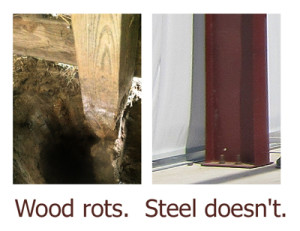Part 4: Looking at Total Lifecycle Costs of Steel Barns vs. Pole Barns
It is not enough to compare only initial costs of materials and construction when choosing between pre-engineered steel framed barns or wood-framed pole barns.
When comparing costs of ownership of any asset, the prudent compare not only initial expenses, but also whole-life costs. This concept is known as “cradle-to-the-grave” or “womb-to-tomb” comparison and is part of the discussion on steel buildings vs. pole barns.
Long Term Vision of Steel Barns and Pole Barns
 In the battle of steel buildings vs. pole barns, steel framed barns will outlast wood every time.
In the battle of steel buildings vs. pole barns, steel framed barns will outlast wood every time.
Pole barn posts— even when pressure-treated with chemicals to increase life— will weather and rot over time.
High-quality metal barns will never rot, mold, deteriorate, or feed termites. Steel does not require treatment with strong chemicals to retard rot or deter termites.
Pole barns used for livestock present another problem— chewing. Animals sometimes gnaw on wood in barns. The chewing damages not only the wood framing, but also causes animals to ingest the chemicals treating the lumber.
Neither livestock nor termites and vermin can make a meal of a steel framed barn kit or metal building.
Big Insurance Savings on Metal Barns
Steel framing is never the first-ignited material in a building fire. Wood framing, however, is often the initial source of ignition.
Once a fire starts, fire-resistant steel framing cannot contribute fuel to the fire. Wood framing, of course, provides perfect fuel to intensify and spread a structural fire.
Lightning, another source of structural fires, is far less likely to damage a properly grounded steel barn or other metal structure than a wood-framed pole barn.
Steel’s fire-resistant properties often earn significant insurance discounts compared to wood structures. Lifecycle costs diminish significantly when you save 30% or more annually on insuring a steel barn or other metal-framed building.
Steel Barns Need Little or No Maintenance
Wood-framed pole barns require costly maintenance. Posts shift in the ground over time. Nails begin to loosen and pull out of the framing. Leaks can multiply as the framing shifts, increasing the chances of rotting or molding.
Pole barns usually need straightening every five to seven years, a process costing thousands of dollars.
Pre-engineered steel barn kits go up straight and stay straight for the lifetime of the building. The strength of steel framed barns— plus the power of the high-strength bolts and framing screw connections— produces a practically maintenance-free structure.
Metal Barns Last Decades Longer than Wooden Pole Barns
Pole barns are not truly “permanent” structures. Typically, a pole barn’s lifecycle is only 15-20 years.
RHINO prefabricated metal barns retain their beauty and value for decades longer than pole barns, increasing future resale value of the property.
Why Pay More for a Building with a Shorter Lifetime?
Metal barns and steel buildings are simply a better long-term value than pole barns.
At the end of its usefulness, steel framing recycles into new steel to produce cars, bridges, ships, trains, or appliances— or another steel building. Discarded wood framing usually winds up taking up space in a landfill somewhere with other construction debris.
Call RHINO today for details on steel framed barn kits or to learn more about steel buildings vs. pole barns at 940.383.9566.
Related Blogs:
- “So What’s the Difference Between Pole Barns and Steel Barn?”
- “Which Is the Better But— Pole Barns or Metal Barns?”
- “Steel Barn vs. Pole Barn: Which I s Easier to Build?”
